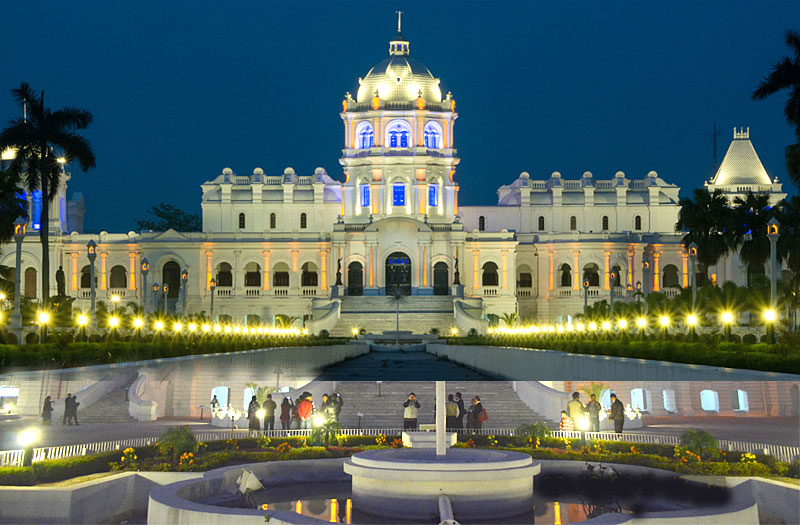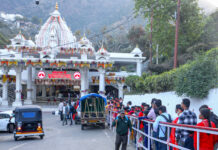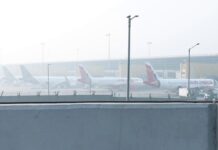Agartala, the capital of Tripura, is arguably one of the most diversely populated cities of India. Tripura has always been a home to various mixes of tribes and all these tribal amalgamations have led to an influx of people representing their own clan.
Agartala, with its verdant forest cover, near perfect green backdrop, great tourist sites and laid back attitude presents a sight of an ideal tourist destination. The rich and varied tribal culture thriving on the high mountains and vast and alluring green valley adds its own charm to the attraction of the state.
Propelled into limelight after Maharaja Krishna Manikya shifted the state capital here in the 19th century, Agartala is not just forests, hills, lakes and wildlife sanctuaries. This city presents life in a totally distinctive way; very unlike the life we in our so-called big cities endure. Replete with religious and historical monuments directly involving great personalities like Gurudev Rabindranath Tagore, Agartala presents a new-fangled aspect of tourism to the visitors for exploration. Located at an altitude of 3,600 ft above the sea level is the highest peak of Agartala region, Beltingchhip (32 km from Vanghmun).
Agartala city, though the most developed in the state, is still a far distance away from the other metros in the country. Thus one can be assured of a pleasant and clean atmosphere, fresh air and unpolluted minds throughout the year. The city is the central market for various commercial goods (tea, rice, jute and oilseed) for the surrounding region. A stroll down the market is a must for the ardent shoppers for the sheer variety of handicraft and woolen articles for display and sale. Watch out for the tribal ladies with their special wares roaming the market and clinch a steal you will remember for your life.
Tourist Attractions
Kunjaban Palace: The Kunjaban Palace (formerly known as the Pushbanta Palace) constructed in 1927 for the King Birendra Kishore Manikya (retreat/ recreation palace) is a marvelous monument which reflects the rich and artistic taste of the erstwhile ruler. The palace was handed over to the Government after dissolution of the monarchy and is presently being utilized as the official residence of the Governor of the State of Tripura.
Neermahal: Neermahal, (Water Palace) located at a distance of around 53 km from Agartala was built as a summer resort for the erstwhile King Maharaja Bir Bikram Kishore Manikya in 1930. The Palace situated right at the center of the Rudrasagar Lake (6 Sq km water body) is a magnificent piece of engineering. The amazing Hindu and Islamic architectural fusion is a rare sight and a pleasing one too.
Ujjayanta Palace: The heart of the city of Agartala presents the Ujjayanta Palace, the famous royal house, beautifully carved and sculpted in Indo-Greek style. Constructed by Maharaja RadhakishoreIan Manikaya in 1901 the palace is nicely located within a huge garden and adorned with pools and fountains. This three-storied monument has three high domes with two large tanks on both sides and the fountains (Musical Fountain or Dance of Fountain is a must see) laid out similar to the Mughal Gardens.
Chittagong Hills: The hills and valleys have always enchanted the human mind however the spectacle presented by the Chittangong Hills spread over a vast region simply sweeps the onlooker off the feet. The hills (as they are inappropriately called) are actually a series of mini mountains deep and far stretching valleys and a mini canyon formed by the mishmash of seven rivers. The rivers, Feni, Karnafuli, Chengi, Myani, Kassalong, Sangu and Matamuhuri cavort and gambol across the valley presenting an enchanting dance of frolic and fun across the ranges.
Jampui Hill: The Jampui hills are also famously known as “the eternal hills of spring”. Situated at a distance of 240 kms from Agartala, the hills are a treasure trove of a wide variety of Orchids, oranges and a heavenly mix of scenic splendor. The place of eternal spring proves worthy of its name due to the fact that the seasons never turn their ugly side towards the Jampui hills. The best comfort and weather is available throughout the year.
Raima Valley: The Raima Valley, also known as the mother of the tribals of Tripura is actually a huge volume of enclosed space created due to the formation of a pleat within the mountain folds permitting the commissioning of the Gumti hydel project on the Raima River. This project caters for augmenting deficit power supply of the state and has a large catchment of water within the Raima valley. The area in general and the Raima valley in particular has seen development as a favored tourist spot over last decade.
Gondacherra Wildlife Sanctuary: Gondacherra Wild Life Sanctuary is a good place to forget all your worries and get lost in the pleasing green forest and pure atmosphere of nature at its primitive best. The wildlife sanctuary provides an opportunity to travel deep inside the park where, untouched by human interference, the natural habitat of many inhabitant animals (tiger, bison, deer, various primates, even a few wild horses) has created a world straight out of Time Travel movies. Apart from the forestry few water bodies along the sanctuary act as the attracting magnets for the resident as well as migratory birds.
Sepahijala Wildlife Sanctuary: The Sepahijala Wildlife Sanctuary is located at a distance of 35 km from Agartala. Spread over an area of 18.5 sq km the Sanctuary boasts of abounding congregation of wildlife, especially birds and primates. The Sanctuary also houses a botanical garden, zoo, a lake and abundance of diverse species of trees. The terrain is absolutely green throughout the year and so is the beautiful weather except for the two humid summer months of March and April.
Buddha Temple: The Buddha Temple, popularly known as the Buddha Mandir, is located at the heart of the city. The temple is one of the important religious centers and provides ample evidence regarding the influence of Buddhism on the populace. The shrine houses two beautiful idols of Buddha and Bodhisattva. The peaceful and serene idols are believed to have a Burmese origin. Shifted from the Royal palace, the idols adopted their new home, the Buddha Temple constructed in 1946.
Jagannath Temple: The city of Agartala was chosen above Udaipur as the capital by the Manikyas. The Manikyas preferred to decorate the city and adorned it with specially created monuments and beauty spots. The Jagganath Dighi Lake is one such ornamental lake specially created. The shores of this pond play host to the Jagannath temple. The idol of Neelmadhav/ Lord Jagannath at Puri is believed to be donated by this temple. The temple overlooking the Jagannath Dighi Lake shows heavy inclination towards Islamic style of architecture and design.
Ummaneshwar Temple: The Ujjayanta Palace milieu houses various temples revered by the populace. The temples of Jagannath and Ummaneshwar are located opposite each other on the green stretches of grass within the palace yard. Culturally and geographically Tripura identifies itself more with West Bengal than the other North Eastern states. Thus it is common to find gods, goddess and temples resembling each other in these two states.
Unakoti: The amazing rock cut carvings and stone images at Unakoti (less than 10 million in Bengali), are located at a distance of 175 kms from Agartala. The archaeologists claim that Unakoti was a Shaivite holy spot in the 8th-9th centuries. The story goes that Lord Shiva was going to Kashi with one crore gods and goddesses. During night halt at this location Shiva asked all gods and goddesses to wake up prior to sunrise.
Best time to visit
Agartala is a place where one can experience moderate weather all through the year. The place can be visited any time the year but the best season is from September to May.
How to reach
By Air: Agartala airport is connected to Indian cities Kolkata and Guwahati. Other metro cities can be reached via Kolkata.
By Bus: There are many road routes to reach Agartala from Kolkata and Guwahati.
By Train: Nearest railway stations are Kumarghat, about 160 km from Agartala and Dharmanagar, 200 km away.







